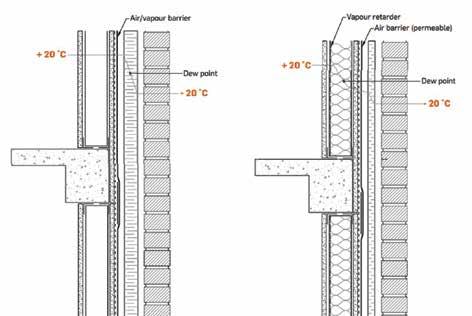
3 minute read
Continuous insulation, why you should have it
Do you want to reduce the risk of condensation and humidity in your buildings? Increase the energy efficiency of your systems and keep the heat inside? With the right insulation product, you can address all these aspects with a single product.
Effective insulation systems slow down heat movement and reduce moisture transfers at an affordable cost.
The importance of good insulation
Insulation products limit heat exchange between the inside and outside of a building in order to make it more efficient. For the highest thermal performance, the construction must be designed to have high thermal resistance (R-value). It is a proven fact that continuous insulation is the most effective method to generate energy savings, as it eliminates thermal bridges through steel, wood, and concrete structures. Continuous insulation is defined as “insulation that is continuous across all structural members without thermal bridges other than fasteners and service openings. It is installed on the interior, exterior, or is an integral part of any opaque surface of the building envelope.” Moreover, it can be used with a variety of wall systems and cladding materials.
Furthermore, continuous insulation can be placed on the interior or exterior side of the wall, thus meeting climatedependent moisture vapour control code requirements. Finally, it is possible to use continuous insulation alone to meet energy code requirements without any cavity insulation, for the ultimate “warm wall” design.
Continuous insulation of a building comes with several benefits:
• Elimination of thermal bridges, which increases the overall performance of the wall assembly
• Money and energy savings, which greatly increases the building’s energy efficiency
• Properly sealed joints minimizing air movement, which reduces infiltration and leaks
• Lower risk of condensation and moisture infiltration
Why you need it
Continuous insulation can serve several important functions in a high-performing wall system, including continuous thermal insulation, moisture vapour control, and water and air barriers. These features provide the following benefits:
• Increased thermal performance
• Lower operating costs
• Reduced air infiltration and exfiltration
• Decreased risk of water condensation and moisture penetration
• Efficient installation
Decreased air leaks, increased energy efficiency
Air leaks are a common problem in a building envelope. They’re essentially the result of uncontrolled air movement and can cause several other problems:
• Condensation
• Moisture
• Mould growth
• Lower air quality inside the building
Understanding water condensation
When it comes to condensation, it is important to know that warm air can hold more water vapour than cold air. When warm air cools, the relative humidity percentage increases and can
reach a saturation level called the dew point. Then, if the air cools even more, the water vapour surplus – which cannot be contained in the air – turns into water droplets, thus forming condensation.
Air leaks through the building envelope are caused by air pressure coming from one or more sources, such as wind pressure, the stack effect, or pressure created by heating, cooling, and ventilation units.
Energy losses caused by air leaks from a poorly insulated building can represent a high percentage of heating and cooling costs. Both in summer and winter, good insulation helps regulate the inside building temperature.
Increased energy efficiency
Model national energy codes are improving the way we approach commercial and residential exterior wall construction by emphasizing the use of continuous insulation systems, which provide a continuous insulation layer over an entire wall, not only in cavities. Building science experts have known for some time that continuous insulation is a very effective way to insulate building envelopes for energy savings. Now, modern building codes are putting this knowledge into practice.
As noted above, continuous insulation is needed to achieve high-performance wall assemblies. As newer national, state and local energy codes continue to put greater emphasis on energy conservation, code developers and experts
are turning to a greater use of continuous insulation for its known ability to reduce thermal bridging and increase energy efficiency at a reasonable installation cost – while providing operating
cost paybacks through reduced energy bills.
Voluntary energy efficiency programs have been encouraging and rewarding the use of continuous insulation for some time. Model building and energy
codes are finally catching up with this proven best practice for wall insulation. n











